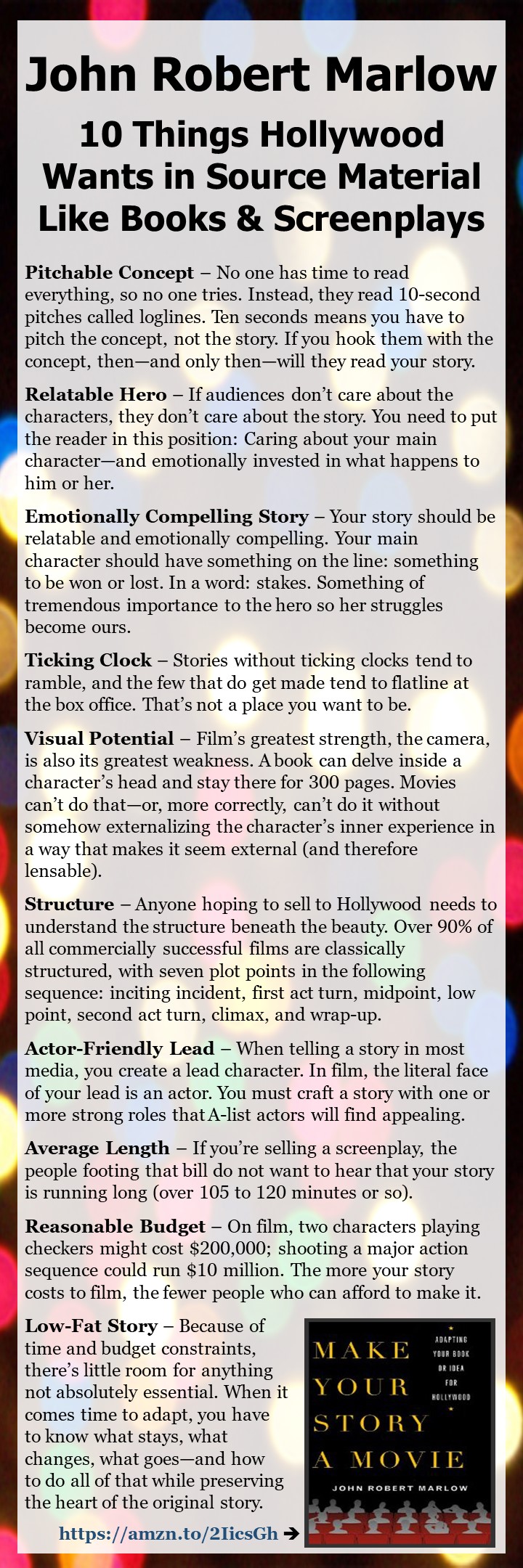Here are 10 things that Hollywood producers and decision makers want in the source material they option – whether from books, screenplays, or pitches.
Pitchable Concept – No one has time to read everything, so no one tries. Instead, they read 10-second pitches called loglines. Ten seconds means you have to pitch the concept, not the story. If you hook them with the concept, then—and only then—will they read your story.
Relatable Hero – If audiences don’t care about the characters, they don’t care about the story. You need to put the reader in this position: Caring about your main character—and emotionally invested in what happens to him or her.
Emotionally Compelling Story – Your story should be relatable and emotionally compelling. Your main character should have something on the line: something to be won or lost. In a word: stakes. Something of tremendous importance to the hero so her struggles become ours.
Ticking Clock – Stories without ticking clocks tend to ramble, and the few that do get made tend to flatline at the box office. That’s not a place you want to be.
Visual Potential – Film’s greatest strength, the camera, is also its greatest weakness. A book can delve inside a character’s head and stay there for 300 pages. Movies can’t do that—or, more correctly, can’t do it without somehow externalizing the character’s inner experience in a way that makes it seem external (and therefore lensable).
Structure – Anyone hoping to sell to Hollywood needs to understand the structure beneath the beauty. Over 90% of all commercially successful films are classically structured, with seven plot points in the following sequence: inciting incident, first act turn, midpoint, low point, second act turn, climax, and wrap-up.
Actor-Friendly Lead – When telling a story in most media, you create a lead character. In film, the literal face of your lead is an actor. You must craft a story with one or more strong roles that A-list actors will find appealing.
Average Length – If you’re selling a screenplay, the people footing that bill do not want to hear that your story is running long (over 105 to 120 minutes or so).
Reasonable Budget – On film, two characters playing checkers might cost $200,000; shooting a major action sequence could run $10 million. The more your story costs to film, the fewer the people who can afford to make it.
Low-Fat Story – Because of time and budget constraints, there’s little room for anything not absolutely essential. When it comes time to adapt, you have to know what stays, what changes, what goes—and how to do all of that while preserving the heart of the original story
Adapted from: Make Your Story a Movie: Adapting Your Book or Idea for Hollywood by John Robert Marlow. Web: http://www.makeyourbookamovie.com.
About John Kremer
John Kremer is author of 1001 Ways to Market Your Books, the Relationships Matter Marketing program, and many other books and reports on book marketing, Internet marketing, social media, and book publicity. -- John Kremer on Book Marketing.

Pingback: Book Marketing Tip of the Week: 20 December 2012 | Book Marketing Bestsellers